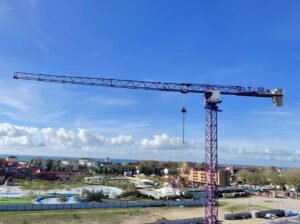1. Enhanced Safety in Multi-Crane Construction Sites
One of the most compelling reasons for the shift towards Flat-Top Tower Cranes is their superior safety in environments where multiple cranes are operating simultaneously. In such scenarios, the lack of a tower head on flat-top cranes minimizes the risk of collisions between the jibs of adjacent cranes. This is especially crucial on densely packed urban construction sites, where space is limited and the safe operation of multiple cranes is a top priority.
2. Faster and More Efficient Assembly and Disassembly
Flat-Top Tower Cranes are designed to be assembled and disassembled more quickly and with fewer parts compared to their hammerhead counterparts. The absence of a tower head simplifies the entire process, reducing the time and labor costs associated with setting up and dismantling the crane. This efficiency is particularly valuable on projects with tight schedules or in urban areas where minimizing disruption is important.
3. Adaptability to Modern Construction Sites
The construction landscape has evolved, with increasingly complex and high-rise projects becoming the norm. Flat-Top Tower Cranes are better suited to these environments due to their lower overall height. This makes them ideal for sites with height restrictions or in areas where cranes need to be placed close together. Additionally, their compact design is easier to integrate into crowded and constrained construction sites, further enhancing their appeal.
4. Reduced Logistics and Transportation Costs
The flat-top design also offers advantages in terms of logistics. With fewer components to transport, Flat-Top Tower Cranes are easier and more cost-effective to move between construction sites. This not only reduces transportation costs but also simplifies the logistics of crane deployment, making it a more attractive option for construction companies operating in multiple locations.
5. Lower Risk of Interference with Other Structures
As construction projects become more complex, the presence of other structures, both temporary and permanent, on a site can pose challenges. The lower profile of Flat-Top Tower Cranes reduces the likelihood of interference with these structures, allowing for smoother and safer crane operations. This is particularly important in urban environments where buildings are often constructed in close proximity to one another.
6. Modern Aesthetics and Technological Advancements
Flat-Top Tower Cranes are often seen as a more modern and aesthetically pleasing option compared to the traditional hammerhead design. In addition to their sleek appearance, they are typically equipped with advanced technology, enhancing their operational efficiency and ease of use. This combination of modern design and cutting-edge technology makes flat-top cranes a preferred choice for forward-thinking construction companies.
Conclusion: The Future is Flat-Top
The construction industry’s shift towards Flat-Top Tower Cranes is driven by their ability to meet the demands of modern construction sites more effectively than Hammerhead Tower Cranes. With advantages in safety, efficiency, adaptability, and cost, flat-top cranes are increasingly becoming the standard choice. As construction projects continue to grow in complexity and scale, the trend towards using Flat-Top Tower Cranes is expected to accelerate, solidifying their position as the future of the industry.






